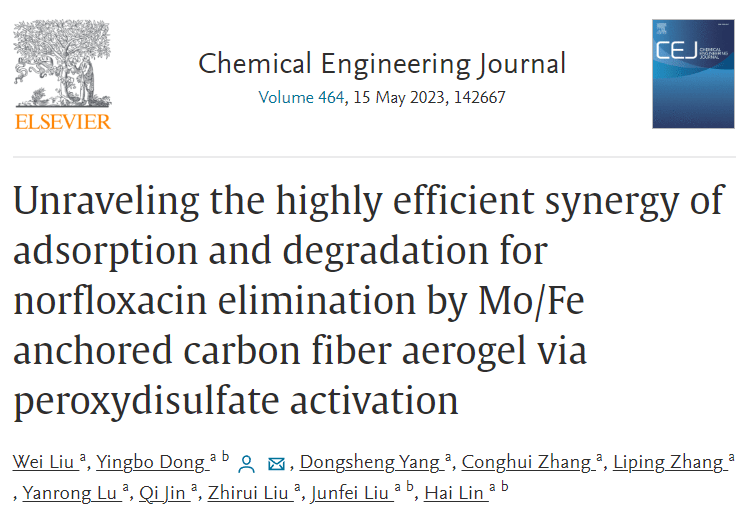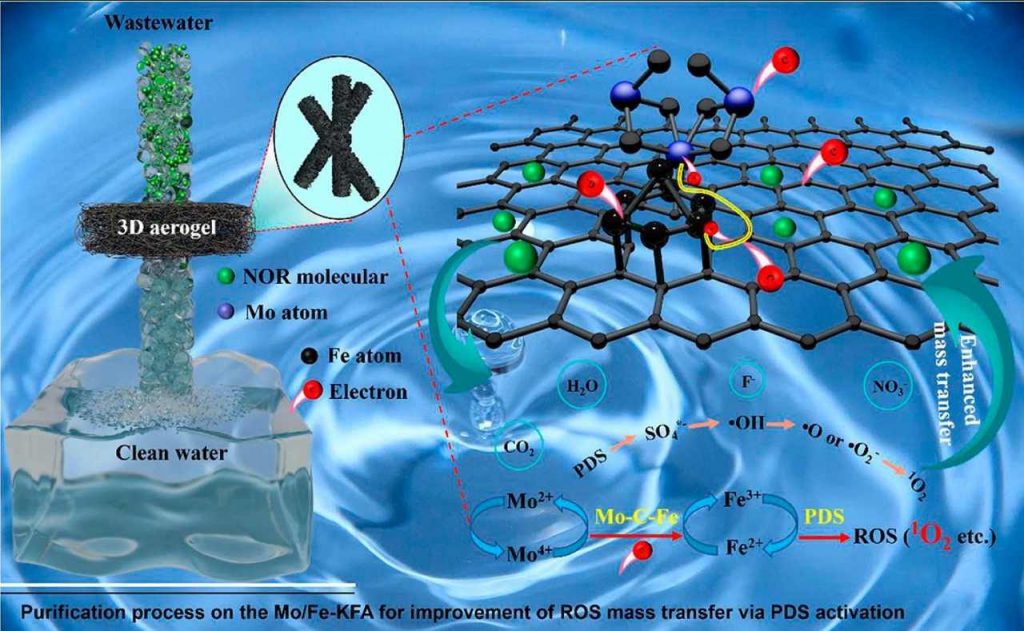
First author: Liu Wei
Corresponding authorProf. Yingbo Dong
Communication UnitSchool of Energy and Environmental Engineering, University of Science and Technology Beijing
DOI: https://doi.org/10.1016/j.cej.2023.142667
✦Graphic Summary✦

✦Results Profile✦
Recently, Wei Liu, a PhD student in the group, published a paper entitled "Unraveling the highly efficient synergy of adsorption and Unraveling the highly efficient synergy of adsorption and degradation for norfloxacin elimination by Mo/Fe anchored carbon fiber aerogel via peroxydisulfate activation". In this study, a novel Mo2C-Fe3C anchored faceted endogenous material carbon fiber aerogel (Mo/Fe-KFA) with a dense 3D fiber structure was constructed to anchor and expose a high density of metal reactive sites. The Mo/Fe-KFA-PDS system achieves NOR removal above 99% in only 5 min over a wide range of pH 3-11 due to the rapid enrichment of norfloxacin at the Mo/Fe interface, thus enhancing the intra-lifetime mass transfer efficiency of the active material. the Mo/Fe-KFA system achieves NOR removal above 99% in only 5 min over a wide range of pH 3-11. the electron transfer between Mo and Fe in Mo/Fe-KFA is accelerated by graphitic carbon chains (Mo- C-Fe) electron transport accelerates Fe3+/Fe2+ cycling and greatly extends the durability of the catalyst with 96 h of continuous operation, retention times of 0.5-1 s, and NOR removal rates of more than 85%. This means that 1 g of Mo/Fe KFA can purify ~43.2 L of NOR wastewater under gravity drive and maintain ~ 85% activity.
✦Abstract✦
In peroxodisulfate (PDS) advanced oxidation processes (AOPs), mass transfer of reactive oxygen species (ROS) and sustainability of the catalyst are rate-limiting steps in the elimination of contaminants. In recent years, norfloxacin (NOR) has received increasing attention due to its potential ecotoxicity. Here, a novel Mo2C-Fe3C-anchored faceted endogenous material carbon fiber aerogel (Mo/Fe-KFA) was constructed to first enrich NOR on the nanosurface and immediately degrade it from the interface in situ by PDS activation. Due to the rapid NOR enrichment at the Mo/Fe interface and enhanced ROS transfer over its lifetime, the Mo/Fe-KFA-PDS system achieved NOR removal above 99% in 5 min over a wide range of pH 3-11. The electron transport between Mo and Fe in Mo/Fe-KFA via graphitic carbon chains (Mo-C-Fe ) electron transport accelerated the Fe3+/Fe2+cycle and greatly extended catalyst durability with 96 h of continuous operation, retention times of 0.5-1 s, and NOR removal rates exceeding 85%. This means that 1 g of Mo/Fe KFA can purify ~43.2 L of NOR wastewater under gravity-driven conditions and maintain ~85% of activity. Combined with DFT calculations, the PDS conversion pathway and the detailed high removal kinetics of NOR and the durability of the catalyst were systematically investigated. Finally, the degradation intermediates of NOR were identified by UPLC-MS and the corresponding toxicity potential was evaluated. This work developed a sustainable, efficient and economical strategy for the purification of aqueous organic pollutants.
✦✦ Author Introduction✦✦

Wei Liu, a PhD student in Environmental Science and Engineering, University of Science and Technology Beijing, Class of 2020, is engaged in research on water pollution control, photocatalytic water purification, Fenton oxidation technology and catalytic materials for environmental water purification. He is responsible for many projects such as the Dongying Groundwater Environmental Condition Survey and Assessment Project, and the Beijing Drinking Water Source Pollution Survey. Finally, I would like to congratulate Dr. Wei Liu once again and wish the graduate students of the group to keep innovating and make further efforts to achieve fruitful results.
Source: Environmental Biotechnology and Environmental Materials Development Team Public

